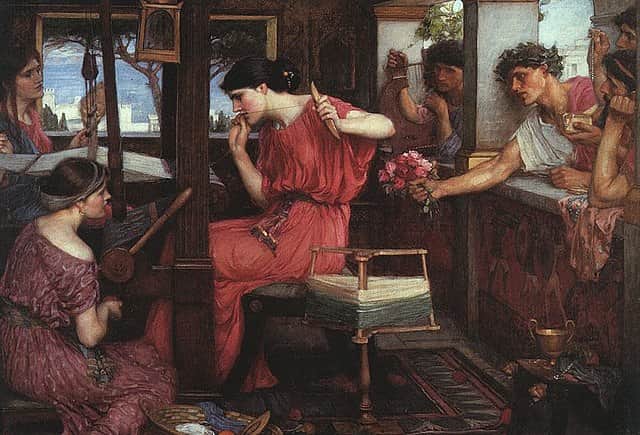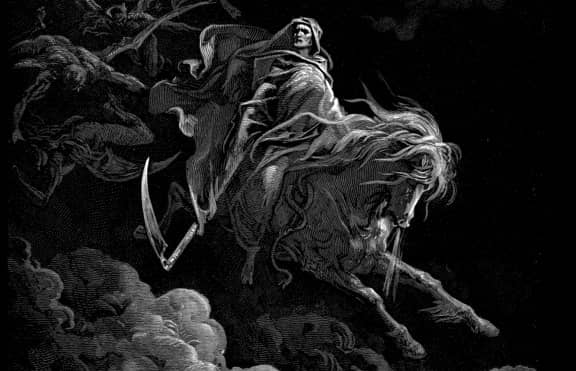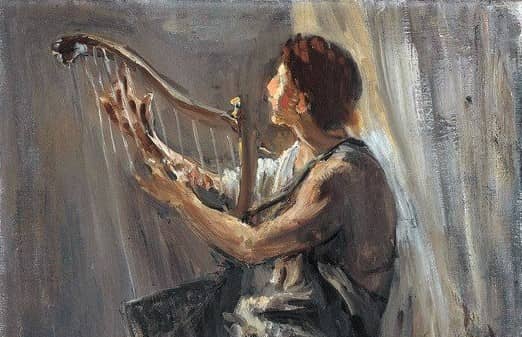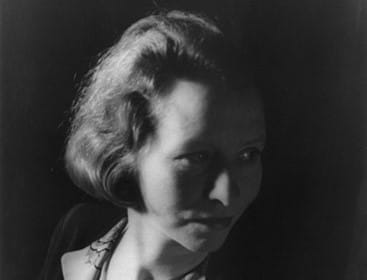What lips my lips have kissed, and where, and why by Edna St. Vincent Millay
“What lips my lips have kissed, and where, and why” is a Petrarchan sonnet written by one of the important American poets of the 20th-century, Edna St. Vincent Millay. This sonnet features Millay’s response to the relationships she had during her 20s. Some of her admirers gave up their virginity to please the red-haired goddess, while some were ready to pledge their lifelong trust. However, Millay regarded physical intimacy differently. So, she rejected all of her suitors, not knowing her indifference and ruthlessness would cause her pain in the upcoming times. The realization did not come too late to ponder upon the emptiness she caused in her heart. She wrote this deeply touching sonnet in 1920 and it was first published in The Harp-Weaver, and Other Poems in 1923.
- Read the full sonnet “What lips my lips have kissed, and where, and why” below:
What lips my lips have kissed, and where, and why by Edna St. Vincent Millay What lips my lips have kissed, and where, and why, I have forgotten, and what arms have lain Under my head till morning; but the rain Is full of ghosts tonight, that tap and sigh Upon the glass and listen for reply, And in my heart there stirs a quiet pain For unremembered lads that not again Will turn to me at midnight with a cry. Thus in the winter stands the lonely tree, Nor knows what birds have vanished one by one, Yet knows its boughs more silent than before: I cannot say what loves have come and gone, I only know that summer sang in me A little while, that in me sings no more. - from The Harp-Weaver, and Other Poems (1923)
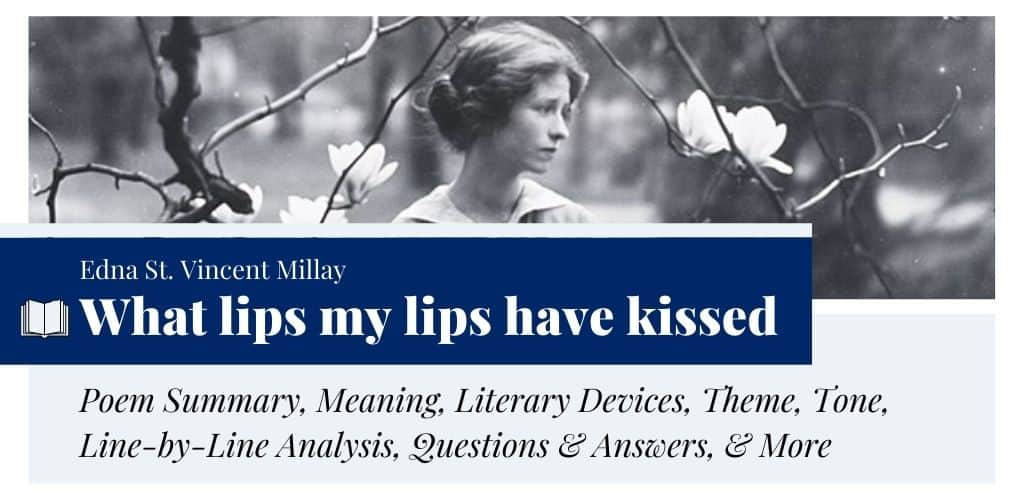
Summary
Millay’s sonnet “What lips my lips have kissed, and where, and why” is about a speaker remembering her past lovers who knock at her heart no more. She distances herself from her emotions and objectively looks back at the events where her lips have kissed and how her head rested against the hands of men till morning. Suddenly, those flowery memories haunt her in the form of ghosts while it rains outside. The tapping of raindrops reminds her of her lovers who don’t turn to her at midnight in the pain of rejection.
The speaker likens herself to a tree of winter, standing alone. It does not know what summer birds twittered on its branches. Only a lasting silence makes it aware of its loneliness. Likewise, the speaker only knows that she has been loved for a little while. Now, there is no one to love her anymore.
Meaning
The title of the sonnet “What lips my lips have kissed, and where, and why” hints at the fact that the speaker (Millay) misses her lover she has been physically intimate with. However, after reading the sonnet, it becomes clear that she does not talk about a single lover. She sighs for the absence of several of her admirers. There is a pain in her heart for the “unremembered lads,” who don’t turn to her at midnight with a hope that she would accept their love. The way, she describes her past lovers, signals the fact that she was objective in her past relationships. The experiences of love without any commitments helped her to inculcate a greater sense of love that is purer than flirtation and freer than lifelong unification.
Form, Rhyme Scheme, & Meter
Structure & Form
“What lips my lips have kissed, and where, and why” is a Petrarchan or Italian sonnet consisting of an octave (the first eight lines) and a sestet (the last six lines). The primary chain of thoughts continues from lines one through eight ending with a full stop. The second movement dealing with the speaker’s greater realization starts from line nine and ends in line fourteen (ending with the second and final full stop). In the octave, Millay uses a comma at the end of line five to mark a shift. The second stanza begins with two commas that make readers pause for a while and think. The colon in line eleven is used to compare the speaker with the lonely tree. Besides, the poem is written from the point of view of a first-person woman speaker.
Rhyme Scheme
The rhyme scheme of “What lips my lips have kissed, and where, and why” is ABBAABBA CDEDCE. So, the octave perfectly follows the Petrarchan model, but the sestet contains a variation. Lines nine and thirteen lines ten and twelve, and eleven and fourteen ends with similar rhyming words.
Meter & Scansion
The sonnet is composed in iambic pentameter. It means each line consists of five iambs (unstressed-stressed) with a few variations. Let’s have a look at the scansion in order to figure out the internal shifts apart from the volta (the transition from the problem to the solution or resolution occurring at the beginning of the sestet).
What lips/ my lips/ have kissed,/ and where,/ and why,
I have/ for-got/-ten, and/ what arms/ have lain
Un-der/ my head/ till morn/-ing; but/ the rain
Is full/ of ghosts/ to-night,/ that tap/ and sigh
Up-on/ the glass/ and lis/-ten for/ rep-ly,
And in/ my heart/ there stirs/ a qui/-et pain
For un/-re-mem/-bered lads/ that not/ a-gain
Will turn/ to me/ at mid/-night with/ a cry.
Thus in/ the win/-ter stands/ the lone/-ly tree,
Nor knows/ what birds/ have va/-nished one/ by one,
Yet knows/ its boughs/ more si/-lent than/ be-fore:
I can/-not say/ what loves/ have come/ and gone,
I on/-ly know/ that sum/-mer sang/ in me
A lit/-tle while,/ that in/ me sings/ no more.
In the octave, Millay uses trochees at the beginning of lines three, four, and five. The falling rhythm resonates with the speaker’s mental state. In the ninth line, Millay uses another trochee at the beginning marking a shift or the volta. There is another slight shift that occurs in the last line, foot three. Readers can clearly see how sadness grips the speaker’s heart again after a moment of inspiring thoughts. The caesuras or metrical pauses (marked by the commas and a semicolon) in lines one, two, three, and four can be comparable with intermittent sighs during lamentation.
Literary Devices & Figurative Language
Millay makes use of the following literary devices in her sonnet “What lips my lips have kissed, and where, and why”:
Synecdoche
The poem begins with the use of synecdoche. Millay refers to the “lips” objectively as if her lips have only kissed the lips of her lovers. The same device is used in “what arms have lain”. Here, the “arms” or “lips” in the first lines refer to the person’s body as a whole. Millay also uses this device in lines six (“heart”) and eleven (“boughs”).
Polysyndeton
It occurs in the first line where “and” is repeated twice to slow down the pace. The commas make readers pause for a while and associate themselves with the speaker’s mental state.
Repetition
There is a repetition of “lips” in the first line for the sake of emphasis. The repetition of “what” in the first two lines also serves this purpose.
Enjambment
This device is used in a number of instances, beginning from the second line. Specifically, it occurs in:
- Lines 2-5
- Lines 6-8
- Lines 13-14
By enjambing these lines, Millay forces us to read them together in order to grasp the overall idea. It also arouses curiosity regarding what will come next.
Metaphor
It occurs in “the rain/ is full of ghosts tonight, that tap and sigh/ Upon the glass and listen for reply”. The poet implicitly compares the raindrops to ghosts that tap upon the glass. The raindrops remind the speaker of her past lovers (an extended metaphor) who tapped on her mind’s glass and eagerly waited for her reply.
In the second stanza, the poet uses an extended metaphor of a tree in the winter. This “lonely tree” represents the speaker (Millay). Similarly, the birds of summer are compared to the lovers in the speaker’s youth.
Alliteration
Alliteration occurs in the following phrases from the sonnet:
- “where, and why”
- “tonight, that tap”
- “turn to”
- “me at midnight”
- “summer sang”
Anaphora
There is a repetition of the same word “I” at the beginning of lines 12-13:
I cannot say what loves have come and gone,
I only know that summer sang in me
Personification
The “tree” is personified in the sestet and invested with the idea of knowing and being lonely. Another personification occurs in “summer sang in me”. The season of summer is invested with the idea of singing. It is actually a reference to the birds of summer.
Line-by-Line Analysis & Explanation
Lines 1-3
What lips my lips have kissed, and where, and why,
I have forgotten, and what arms have lain
Under my head till morning;
The sonnet “What lips my lips have kissed, and where, and why” by Edna St. Vincent Millay begins with a sense of objectivity and nostalgia. The poetic persona representing the poet herself in a thought-provoking and inquisitive tone tries to remember the moments of physical intimacy with her past lovers. She does not differentiate between one lover from others. Rather, she thinks about the “lips” that pressed against hers and where they went for what purpose.
The reference to only the lips, not those who actually kissed her, sheds light on the mindset of the speaker. She was distant in her past relationships. The physical closeness did not result in a long-lasting relationship, or she did not desire to progress that way. Besides, she has forgotten how the lips roamed about her body. In a similar way, she points at the “arms” of her lovers that lay under her head, while she slept till the morning.
In this way, the speaker tries to define what she thinks about love. According to her, love is a language that is beyond one’s identity. Those who loved her communicated differently with their physical moves. But, the underlying message remained the same. They all loved her and wanted her truly. In the present moment, their absence makes her sad.
Lines 3-5
… but the rain
Is full of ghosts tonight, that tap and sigh
Upon the glass and listen for reply,
There is a shift in the subject matter. The use of “but” marks the shift. In these lines, the tapping of the raindrops on the glass reminds her of her past lovers. Though she has forgotten how the lovers kissed her, the sound of the rain somehow stirs the faded memories.
It is important to understand the connotation of the word “ghosts”. The speaker likens the raindrops to ghosts, representing the memories of her lovers. Here, “ghosts” represent the past that taps and sighs upon her mind’s glass. It seems the faded images of her admirers (like unearthly beings) are standing behind the hazy glass, waiting for her reply to their proposals. In this way, Millay beautifully connects the auditory image of raindrops tapping on the glass with that of her lovers.
Lines 6-8
And in my heart there stirs a quiet pain
For unremembered lads that not again
Will turn to me at midnight with a cry.
The sound of raindrops reaches the speaker’s heart and stirs a “quiet pain”. Millay adds a personal metaphor, “quiet” to the speaker’s “pain”. This suffering is more inward that increases gradually with each tap on the glass. The wind blowing outside seems like the sighing of her past lovers. Their absence in the present moment makes her sad. She cannot remember their names, yet she misses their presence and how they gave her importance. Moreover, she misses those days when the lovers would turn to her at midnight with a hope that she would accept their love. When she rejected them, they would cry in pain. There is irony in the speaker’s tone as she utters these lines.
Lines 9-11
Thus in the winter stands the lonely tree,
Nor knows what birds have vanished one by one,
Yet knows its boughs more silent than before:
The volta of “What lips my lips have kissed, and where, and why” in these lines as the speaker reaches an optimistic conclusion. She does not feel discouraged by the fact that she is not wanted like before. Rather, she has a greater realization presented by the images of the seasonal change.
Millay depicts a lonely tree of winter. It does not know what birds have vanished one by one as the seasons passed by. It only feels that its “boughs” are more silent than before. In this way, Millay compares the tree to the speaker’s soul. The “birds” represent the “unremembered lads” that vanished over time. Alongside that, the “branches” growing from the tree stand for the speaker’s body.
The soul of the tree does not interact with the birds directly. Its branches do the work. So, through these lines, it can be inferred that the speaker did not have the experience of spiritual love, or she refrained from indulging in one as she was already married to something else (such as poetry).
Lines 12-14
I cannot say what loves have come and gone,
I only know that summer sang in me
A little while, that in me sings no more.
In the last tercet, Millay likens the speaker to the “lonely tree”. She compares the “birds” to past “loves” or lovers. Though she cannot remember what lovers have come and gone, she only knows that once the “summer” (the birds of summer) sang in her. It is important to note the phrase “sang in me”, especially the preposition. Prior to this line, she creates a sense of detachment with her language. However, in this line, she talks about how the song, symbolizing love, reached her heart.
The uplifting tone changes in the last line. The iambic rhythm drops bear the second foot “-tle while,” and the next part after the comma starts with a trochee (falling rhythm). This modulation hints at the fact that the speaker has come to the same point she began with: the “unremembered lads” do not sing within her anymore.
Themes
Remembrance & Forgetfulness
One of the important themes of “What lips my lips have kissed, and where, and why” is remembrance or recollection. The main idea of the poem deals with a speaker trying to recollect the memories of her past loves. She cannot remember any of them, yet there is a realization that she was wanted and loved. This remembrance is caused by the absence of love in the speaker’s heart. No matter how hard she tries, she fails to even differentiate one memory from the others. Thus, she sees a collective picture of her past, speckled with the memories of her lovers.
Platonic Love
This sonnet explores the theme of platonic love that is neither overtly sexual nor passionate. The speaker describes how she has been raised through the level of closeness to wisdom and true beauty (depicted through the metaphor of the lonely tree), from bodily attraction to spiritual depth. However, the union with truth has not yet occurred in the speaker’s case as she still misses her youth or the attention of her lovers. Hopefully, one can speculate that the pain she suffers now would result in a greater realization when she grows more mature.
The Song of Youth
Another important theme of the poem is youth. In the octave, she misses the physical proximity with her lovers. The tapping of raindrops on her window strikes a silent chord in her heart. This chord created a beautiful tone during her youth. As she grows older and the youthful days fade away, she can feel its absence that once made her feel that love’s music would never stop. Thus, in the sestet, she describes that the “summer” (a symbol of youth) once sang in her, but now the “winter” (a symbol of aging) sings no more.
Tone
Throughout the sonnet “What lips my lips have kissed, and where, and why,” the tone is nostalgic, sad, and thoughtful. In this piece, the speaker misses her youth when she had several admirers. She specifically misses their presence, care, and attention. As she grew older, the birds of summer (lovers of youth) flew away. Now, her mind’s boughs remain more silent than before. The absence of the seemingly everlasting “song” is enhanced by the effect of aging on her mind. For this reason, readers can also sense a deeper agony in her voice alongside grief and nostalgia.
Imagery
Millay uses different types of imagery in the sonnet that include:
- Visual Imagery: In “What lips my lips have kissed, and where, and why,” Millay uses the visual images of lovers kissing each other, raining, and a lonely tree of winter.
- Tactile Imagery: The first three lines present tactile imagery dealing with the sense of touch. Millay describes how her lovers kissed her and laid their hands underneath her head.
- Auditory Imagery: There is an auditory image dealing with the tapping of raindrops on the glass. In the sestet, the poet implicitly conveys the twittering of the summer birds by using this type of imagery.
- Organic Imagery: This type of imagery conveys a speaker’s inner emotions. In this sonnet, readers can find the use of this imagery in “And in my heart there stirs a quiet pain,” “Yet knows its boughs more silent than before,” and “A little while, that in me sings no more.”
Symbolism
Millay uses symbolism in order to enhance her ideas. The important symbols present in the sonnet include:
- Raindrops: The first symbol appears in the third line of the octave. Traditionally, the rain symbolizes sadness, nostalgia, and heartache. Millay particularly emphasizes the raindrops symbolizing the memories of her youth.
- Winter: The sestet begins with the symbol of winter that stands for loneliness and aging.
- Summer: In contrast to the winter symbol, summer symbolizes youth and love. The speaker describes how the summer sang in her. It is actually a reference to her youth and its song symbolizes attraction and love.
- Tree and Boughs: The lonely tree of winter stands for the speaker who is transitioning from her prime to the end of her youth. Whereas its boughs represent the memories of her past loves.
- Birds: The “birds” are the symbol of her past lovers singing within her heart with affection, care, and longing.
Historical Context
Edna St. Vincent Millay wrote the deeply nostalgic sonnet “What lips my lips have kissed, and where, and why” in 1920 when she was 28 years old, nearing her end of youth. From a young age, Millay had several admirers and lovers, including both men and women. When she came to New York in 1917, her looks coupled with her unique poetry were cherished in the literary circle. She had relationships with writer Floyd Dell, poet Arthur Davison Ficke (for whom she wrote an entire collection Second April), and the editors of Vanity Fair magazine, John Peale Bishop and Edmund Wilson (Wilson proposed marriage to Millay).
Nearing her 30s, Millay suffered from fatigue and a number of other illnesses. Thus, she had to move to France in 1921 for a change. However, in his trips to Europe, she became more ill and later returned to her home on her mother’s pressing. With this short sketch of Millay’s personal life, readers can easily interpret the subject matter of the sonnet. Writing this sonnet, Millay looks back at the days when she had several admirers who dreamed of having her as their wife. But, she was so deeply attached to her poetry that she could not commit to a lifelong relationship.
Therefore, she had to reject many and focus on one that is her poetry, the only love of her life. The relationships she had in her life are nothing but the boughs of Millay’s extending its twigs to give shelter to several birds in order to gain manifold experiences for heightening her verse.
The sonnet “What lips my lips have kissed, and where, and why” first appeared in the November 1920 issue of Vanity Fair. In 1923, it was first published as Sonnet XIX in Millay’s Pulitzer Prize-winning collection The Harp-Weaver, and Other Poems. After Millay’s death, it was included as Sonnet 43 (XLIII) in her 1956 book of poetry, Collected Poems.
Questions and Answers
“What lips my lips have kissed, and where, and why” is one of the best poems of Edna St. Vincent Millay, written in 1920. This sonnet is about the mellowing memories of the speaker’s past loves and the piercing pain of her fading youth. She tries to recount the moments of lovemaking but fails to do so. It stirs a deeper pain and a greater realization depicted through the metaphors of a lonely tree in winter and the song of summer birds. The tone of this piece is similar to Millay’s other sonnet “Time does not bring relief.”
The title of the poem “What lips my lips have kissed, and where, and why” by Edna St. Vincent Millay directly hints at the subject matter of the poem. It revolves around the faded memories and a sense of uncertainty regarding the past. As the speaker gradually nears the end of her youth, the picturesque, splendid memories of past love become hazy. There stirs a quiet chord of pain in her heart resonating with her loneliness. This piece, when read alongside “Love Is Not All,” one of Millay’s finest sonnets, shows how the poet’s realization of love changed with time.
Millay’s sonnet contains a number of important themes, including youth, time, remembrance, change, and love (specifically platonic). The main idea of the poem revolves around the poet’s forgetfulness of her youthful days when she had several admirers both men and women.
The tone of “What lips my lips have kissed, and where, and why” is nostalgic, sad, and thoughtful. Millay’s persona sadly describes her forgetfulness of the past loves that once sang within her heart like the birds of summer upon boughs. There is also a sense of irony in the speaker’s tone as she objectively describes her personal events.
The message of “What lips my lips have kissed, and where, and why” is that youth is like the summer of one’s life. Then a person believes that the happy moments are never going to end. When we near the end of our youth, we realize the truth that what once sang in our hearts is nothing but a fair-weather bird of summer.
Millay uses a number of literary devices in the sonnet that includes metaphor, synecdoche, personification, repetition, enjambment, anaphora, and alliteration. Alongside that, she also uses symbolism, imagery, and caesuras to enhance the figurative effect.
One of the important metaphors in the sonnet is “the rain” or specifically the raindrops compared to the ghosts. The poet likens them to her past lovers who tapped on the glass and waited for her reply. In the sestet, she uses the extended metaphors of the tree, boughs, and birds.
This phrase contains a metaphor. Here, the raindrops are compared to the ghosts that tap on her window. The sound seems to haunt her as it reminds her of her past lovers. Like ghosts, her past lovers have no existence in the present moment but still, their traces are there in her heart.
In this line, “summer” symbolizes youth. It means that when the poet was young, she felt like the youth sang in her heart like the birds of summer. These birds, on the other hand, represent her past partners.
The volta, like any other traditional Petrarchan sonnets, occurs in the sestet. In this section, Millay comes to a solution (or resolution). She accepts reality as it is and somehow tries to move on with wisdom. But, she returns again to the same point as the emotions hold her back.
The rhyme scheme of “What lips my lips have kissed, and where, and why” is ABBAABBA CDEDCE. The octave aptly follows the Petrarchan rhyming pattern, but the sestet contains a slight variation.
Similar Poems about Remembrance & Heartache
- “I wish I could remember that first day” by Christina Rossetti — In this sonnet, the speaker talks about the forgetfulness of her first love.
- “When I Was Fair and Young” by Queen Elizabeth I — This poem is about the transience of youth and the suffering caused by love’s absence.
- “Spring” by Edna St. Vincent Millay — It’s about the speaker’s disillusionment concerning the beauty of spring.
- “The Heart asks Pleasure—first—” by Emily Dickinson — This poem highlights what a person needs the most, down to the least.
Useful Resources
- Check out The Loves and Love Poems of Edna St. Vincent Millay — Explore how Daniel Mark Epstein tells the amazing story of Millay’s life, dedicated to art and passion.
- The Sonnet Aloud — Listen to poet Nancy Hodermarsky reading Millay’s sonnet.
- A Musical Representation — Watch this beautiful musical performance of Millay’s sonnet. It’s from Sheila Silver’s songbook on Millay’s poetry, Beauty Intolerable.
- About Edna St. Vincent Millay — Learn about the poet’s life.
- Poet Profile of Millay — Read more about the poet’s life and works.

